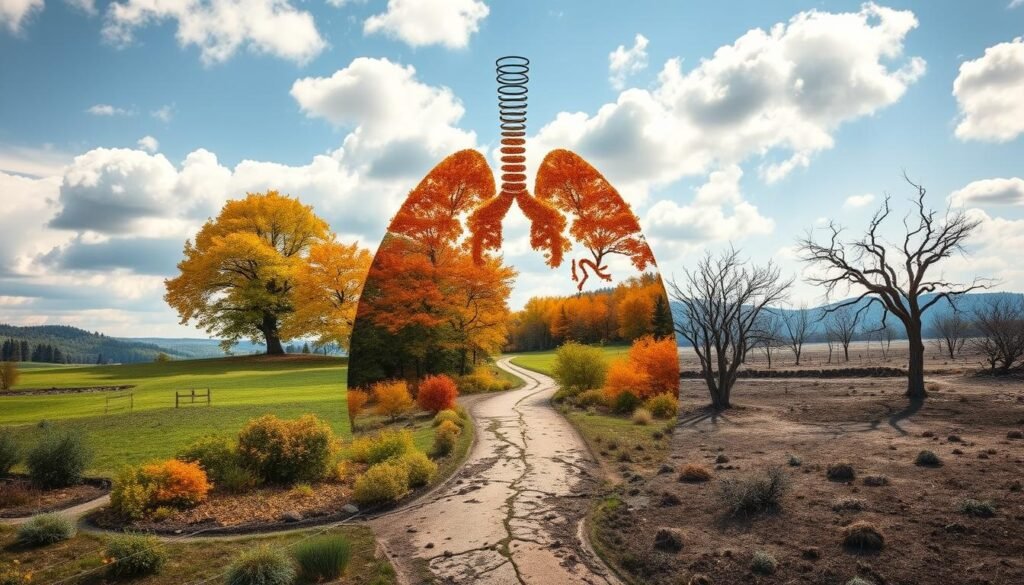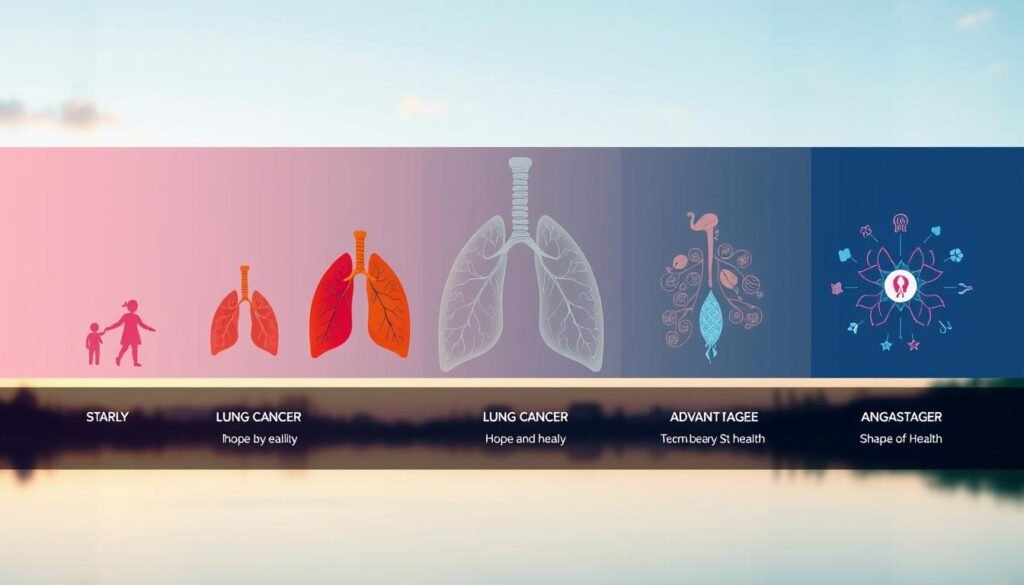Did you know about the 18.6% five-year survival rate for lung cancer patients? This fact shines a light on the struggles they endure. It also shows why it’s critical to know about life expectancy with lung cancer. The outcome can be very different depending on the cancer’s stage when found and its type. In this article, we aim to give detailed insights into what one might expect after a diagnosis. We will cover survival rates, treatment choices, and medical progress that could help.
Key Takeaways
- Life expectancy varies by lung cancer stage and type.
- Early detection significantly impacts survival rates.
- Understanding treatment options can help improve prognosis.
- Lifestyle changes may positively affect overall health during treatment.
- Statistics show a wide range of survival rates for different stages of lung cancer.
Understanding Lung Cancer and Its Types
Lung cancer is a significant health concern that comes in different types. These types affect diagnosis, treatments, and how patients will recover. Generally, lung cancer falls into two categories: non-small cell lung cancer and small cell lung cancer. Knowing about these helps doctors and patients choose the best treatment path.
Overview of Lung Cancer Types
Non-small cell lung cancer (NSCLC) makes up about 85% of lung cancer cases. It grows more slowly than the other main type, small cell lung cancer (SCLC). SCLC spreads fast to other parts of the body and is very aggressive. Identifying the type of lung cancer is key to finding the right treatment.
Differences Between Non-Small Cell and Small Cell Lung Cancer
Non-small cell lung cancer and small cell lung cancer differ mainly in how they spread and respond to treatment. NSCLC includes several subtypes like adenocarcinoma, squamous cell carcinoma, and large cell carcinoma. SCLC, in contrast, is much more aggressive and often comes back after treatment. For more information on treatments, check out this resource.
Life Expectancy After Lung Cancer Diagnosis
Knowing what to expect after a lung cancer diagnosis is key. Several factors play a big role in outcomes. These include the lung cancer type, how advanced it is, the patient’s age, their overall health, and specific genetic factors. These lung cancer life expectancy factors are crucial. Statistics show survival rates vary greatly. For example, overall, only 17% of lung cancer patients live more than five years. But, for stage 1 non-small cell lung cancer (NSCLC), the five-year survival rate is much higher, between 70% and 92%.
Factors Influencing Life Expectancy
Each person’s lung cancer journey is different. Main factors that impact life expectancy are:
- Cancer Type: NSCLC is more common and often has better survival rates than small cell lung cancer.
- Stage at Diagnosis: Finding the cancer early often leads to more effective treatments.
- Age and Overall Health: Younger, healthier patients usually do better.
- Genetics: Certain gene mutations can change treatment outcomes.
Take localized NSCLC: its five-year survival rate is around 65%. But for widespread cancer, it falls to 8%. Living a healthy life helps too. This means exercising often, getting help for mental health, and eating well.
Importance of Early Detection
Spotting lung cancer early is crucial to living longer. Early-stage treatment works better, boosting survival chances. This underlines how key regular checks are for those at high risk. Screenings catch cancer early, leading to better results. Support from groups like Lung Foundation Australia makes a big difference too. For deep dives into lung cancer and why early action is vital, check out this detailed resource.

Statistics on Lung Cancer Survival Rates
Lung cancer survival rates show how well treatment works. These rates help people understand what to expect on their journey. In the last five years, the survival rate has gone up by 26%, now at 28.4%. But, lung cancer is still tough, with less than 20% living past five years after finding out they have it.
Five-Year Survival Rates Overview
The five-year survival rates differ by lung cancer type and stage. For the most common type, non-small-cell lung cancer (NSCLC), survival rates change depending on how far the cancer has spread:
| Stage | Localized | Regional | Distant | Overall |
|---|---|---|---|---|
| NSCLC | 60% | 33% | 6% | 23% |
| SCLC | 29% | 15% | 3% | 6% |
Statistics show a big gap between early and advanced lung cancer stages. Localized NSCLC has a 60% five-year survival rate. But, localized SCLC’s rate is about 29%. These numbers highlight the importance of catching the disease early.
Survival Rates by Cancer Type
The kind of lung cancer affects how long people live after diagnosis. Small-cell lung cancer has only a 6% five-year survival. But, early-stage non-small-cell lung cancer gives people a better chance. The TNM staging system helps doctors predict outcomes and plan treatments. It looks at tumor size, if it has spread to lymph nodes, and if it has reached other parts of the body.
If you want to know more about how lung cancer is classified, check out this resource. Recent studies suggest that yearly scans can lower lung cancer deaths by 20%. This step could save lives and reduce healthcare costs.

Life Expectancy by Lung Cancer Stages
Lung cancer’s stage when found affects how long people might live. Knowing the stages helps pick the right treatment and set expectations. For example, catching lung cancer at Stage 1 means better chances than at Stage 4.
Stage 1: Early Detection and Survival
In Stage 1, especially Stage 1a, the five-year survival rate for non-small cell lung cancer (NSCLC) is really high, between 70% and 92%. Stage 1a has a remarkable five-year survival rate of 92%. But Stage 1b’s survival rate falls to 68%. Finding it early through screenings can really help, making treatments like surgery more likely to work well.
Stage 4: Impact on Life Expectancy
But, Stage 4 lung cancer brings a sharp drop in how long people might live. For advanced small cell lung cancer, the five-year survival rate is just 3%. And, for metastatic NSCLC, it’s about 8%. Studies say about 25-30% of people with advanced NSCLC live less than three months. This shows how crucial early finding and treatment are. More details on survival rates can be found here.

Lung Cancer Treatment Options and Outcomes
Lung cancer treatments vary by the cancer’s type and stage. Each treatment affects outcomes and life expectancy differently. Knowing these options is key to managing lung cancer effectively.
Common Treatment Methods
There are several ways to treat lung cancer, including:
- Surgery: Usually best for early-stage non-small cell lung cancer (NSCLC).
- Chemotherapy: Often used first for advanced stages to help patients live longer.
- Radiation Therapy: Good for localized cases or to ease symptoms as palliative care.
- Targeted Therapy: Attacks specific genes to get better results.
How Treatments Affect Life Expectancy
How well lung cancer treatments work can be shown in numbers. Surgery for early-stage NSCLC can mean living about 76.7 more months. But, advanced stage patients getting chemotherapy may live 8-10 more months. These differences highlight why it’s vital to tailor treatment plans. Combining treatments often gives better outcomes.
| Treatment Method | Stage of Lung Cancer | Life Expectancy Outcome |
|---|---|---|
| Surgery | Stage I-III | Average of 76.7 months |
| Chemotherapy | Stage IV | 8-10 months |
| Radiation Therapy | Localized / Palliative | Variable; improves quality of life |
| Targeted Therapy | Based on Genetics | Depends on mutation type |
Improving Lung Cancer Life Expectancy
Changing your lifestyle can really help improve how long people with lung cancer live. Starting healthier habits and using new ways to treat the disease are key. They can boost survival chances for people with lung cancer.
Healthy Lifestyle Changes
Some changes in how you live can make a big difference in your health. It’s suggested to:
- A balanced diet: Eating lots of fruits, veggies, and whole grains helps protect your body.
- Regular physical activity: Working out often makes you stronger and enhances your life quality.
- Avoiding tobacco smoke: It’s crucial to stay away from smoking and being around smoke for healthy lungs.
These changes are important. They can help people with lung cancer live longer by fighting some of the disease’s bad effects.
Advancements in Medical Treatments
There’s been a lot of progress in how we treat lung cancer. This gives patients better options, like:
- Immunotherapy: This method uses your immune system to attack cancer cells more effectively.
- Precision medicine: This is when treatments are chosen based on a person’s genetic makeup for the best results.
These new treatment ways really help in making lung cancer patients live longer. They bring more hope and chances for people to survive longer.
Lung Cancer Prognosis: What to Expect
The outlook for lung cancer greatly shapes how patients approach treatment and view their future. Factors like cancer traits, diagnosis stage, and patient health come into play. Often, lung cancer is caught late, affecting both prognosis and treatment choices. It’s known that stage IV lung cancer has a low five-year survival rate. This fact shows why finding cancer early is crucial for better results.
Understanding Prognosis and Its Implications
Knowing your lung cancer outlook helps set treatment and life expectancy goals. Generally, lung cancer’s five-year survival rate falls between 9.5% and 16.8%. This varies by cancer type and stage. Late-stage diagnoses, especially stage IV, bring tougher challenges and lower survival chances. Catching cancer early can make treatments more effective, leading to improved health. It’s key for patients to talk openly with doctors about their treatment and outcome expectations. For insights into lung cancer stages and prognosis, check this resource.
Coping with Prognosis and Life Expectancy Concerns
Learning you have lung cancer brings many emotions and questions about life span. Effective coping methods are essential. It’s good to seek help from healthcare teams, support groups, and mental health professionals. Being active in your care fosters control and understanding of your outlook. This helps in managing your treatment path. Having support boosts your strength in facing challenges.
Life Expectancy Statistics by Specific Cancer Types
Understanding lung cancer life expectancy is key for patients and their families. It lets them choose wisely regarding treatments. Lung cancer mainly falls into two categories: Non-Small Cell Lung Cancer (NSCLC) and Small Cell Lung Cancer (SCLC). Each type has its own survival outlook.
Non-Small Cell Lung Cancer Statistics
Non-Small Cell Lung Cancer makes up about 80% to 85% of lung cancer cases. Its survival rates vary greatly by the stage when found. Here’s a quick overview:
| Stage | 5-Year Survival Rate |
|---|---|
| Localized | 65% |
| Regional | 37% |
| Distant | 9% |
As cancer moves from localized to distant, survival chances drop. This shows how vital early detection is.
Small Cell Lung Cancer Statistics
Small Cell Lung Cancer accounts for about 10% to 15% of cases. It usually has a tougher prognosis. Look at these survival rates:
| Stage | 5-Year Survival Rate |
|---|---|
| Localized | 30% |
| Regional | 18% |
| Distant | 3% |
The data show clear differences in survival based on lung cancer types. SCLC’s survival rates are lower, especially in late stages. This highlights the importance of quick and effective treatment.
Conclusion
Life expectancy after lung cancer depends on the cancer type, stage, and treatment. For non-small cell lung cancer (NSCLC), the five-year survival rate can be up to 65% if found early. But, small cell lung cancer (SCLC) has a lower survival rate when it advances.
Treatment advances can greatly improve survival chances. Getting treated quickly, within four to six weeks, can lower death rates. Also, not smoking and taking vitamins might help people live longer after lung cancer.
Talking with healthcare providers is key when dealing with lung cancer. They help create treatment plans that meet each patient’s needs. Knowing about lung cancer helps patients and families make choices. These choices can lead to a better life during cancer treatment.